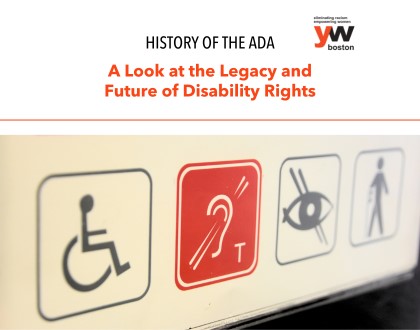History of the ADA: A Look at the Legacy and Future of Disability Rights

July is Disability Pride Month, culminating with National Disability Independence Day on July 26, which commemorates the signing of the Americans with Disabilities Act (ADA) in 1990. The very first Disability Pride celebration was held in Boston that same year. Carrying on that tradition, Disability Pride Month is celebrated in Boston and in cities across the country today, giving people with disabilities and their intersecting identities a chance to celebrate their uniqueness and challenge stigmas and ableism.
This year is the 33rd anniversary of the ADA, which brings an opportunity to explore the significant history of this landmark act as well as where disability rights are today. The signing of the ADA was called the “world’s first declaration of equality for people with disabilities” by then-vice chair of the National Council on Disability, Justin Dart. Subsequent Supreme Court cases aimed to limit the definition and scope of “disability.” The ADA Amendments Act of 2008 expanded the definition to include a broader range of individuals that are protected under the ADA.
The ADA and its amendments set standards for accessibility, including the implementation of elevators and ramps, access to large-print books in schools, and the availability of sign language interpreters and audio description devices. These measures help create a more inclusive society where everyone can participate, but there are still gaps.
One major issue faced by the disability community today is unemployment. According to the 2022 Current Population Study by the Department of Labor’s Bureau of Labor Statistics, the unemployment rate for people with disabilities was 7.6% in that year. In comparison, the unemployment rate for people without disabilities was 3.5%. It’s important to acknowledge this disparity and the stereotypes, perceived limitations, and barriers disabled people face in the workforce.
People who identify as having a disability make up the largest minoritized group in the United States, and many also identify with other marginalized groups. It’s important to keep in mind the intersection of disabilities with other identities such as race, gender, and LGBTQIA+ identities. Recognizing and acknowledging the multiple intersections of disabilities with other identities is an essential step towards fostering inclusivity and understanding for all individuals in the workplace and beyond.
YW Boston can help you create the necessary cultural shift that will support inclusive policies and practices in your organization. Click here to learn more about InclusionBoston, a comprehensive DEI solution with long lasting results.
